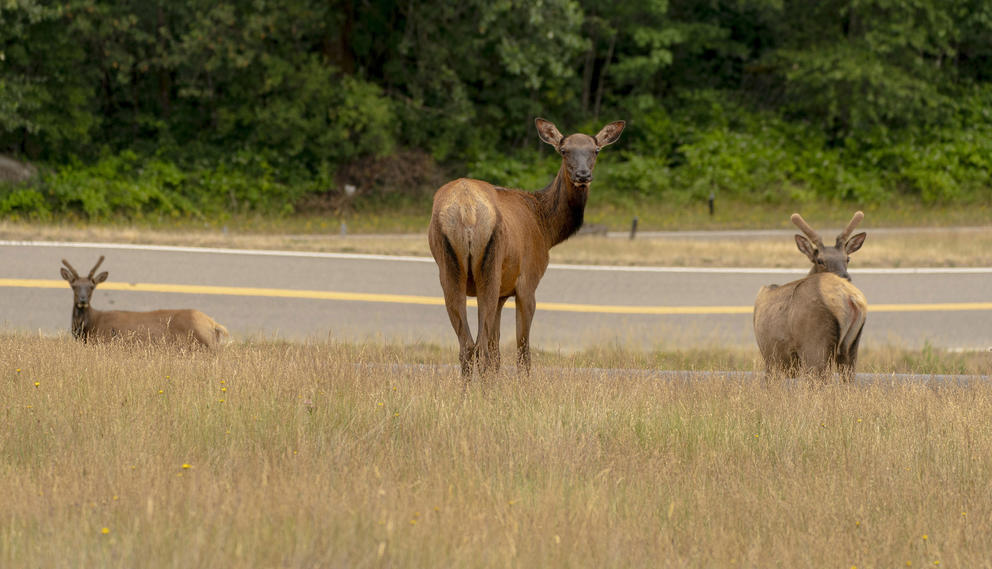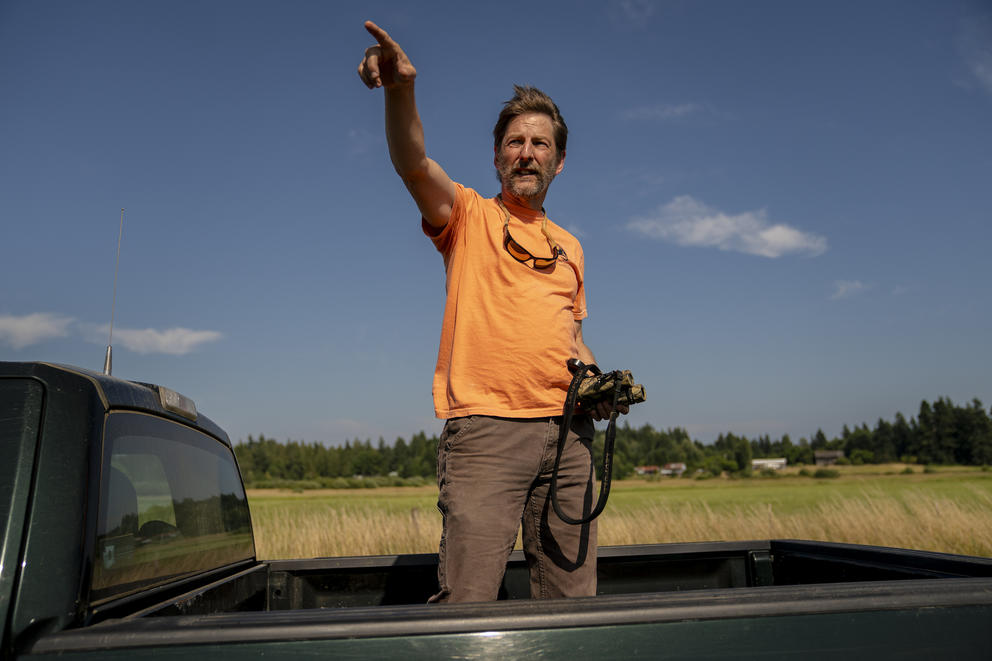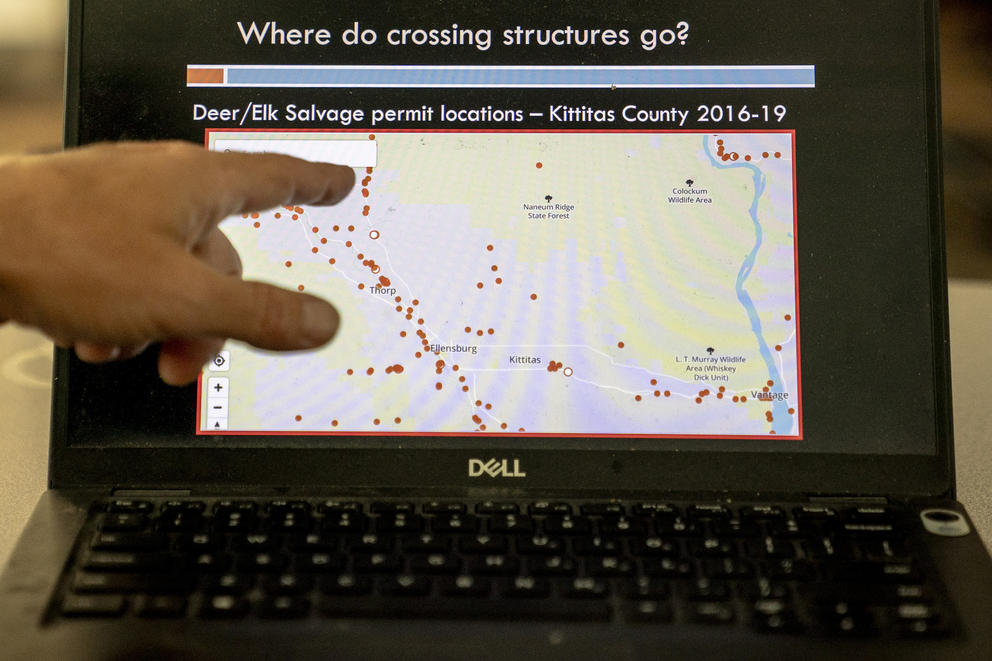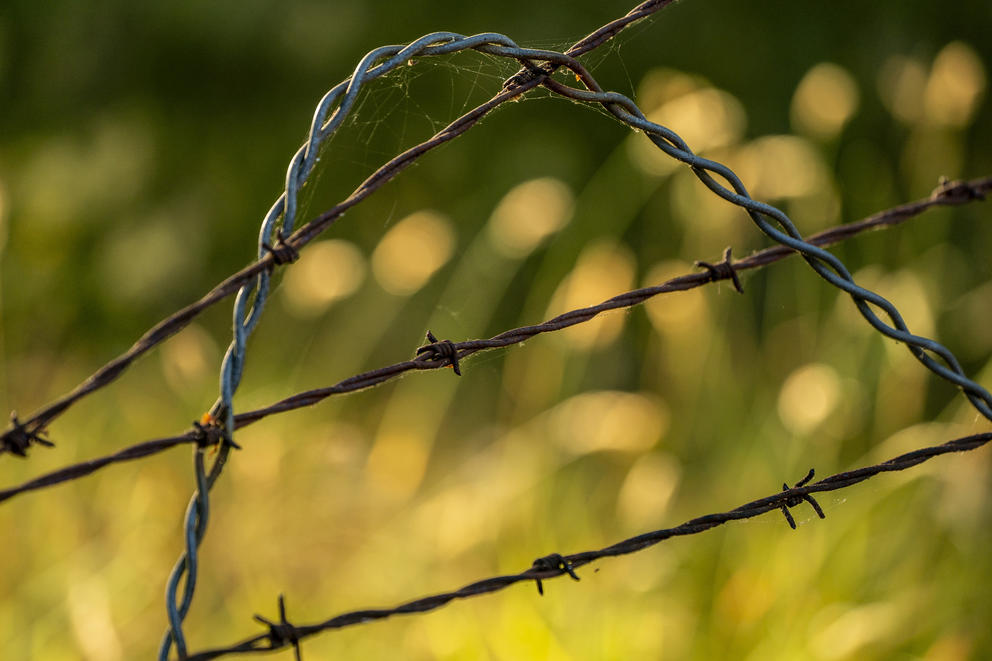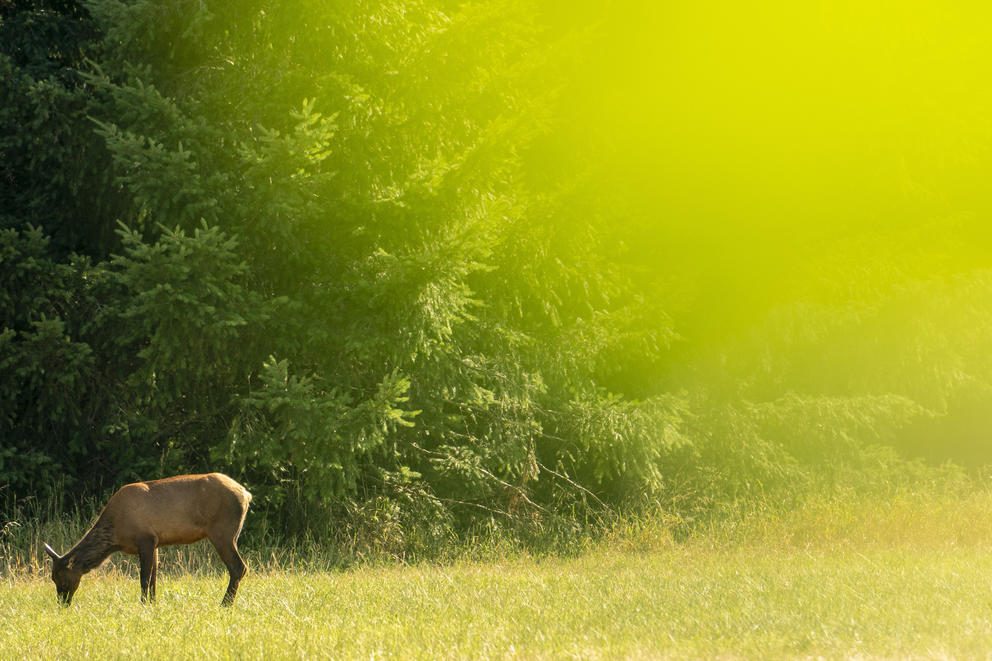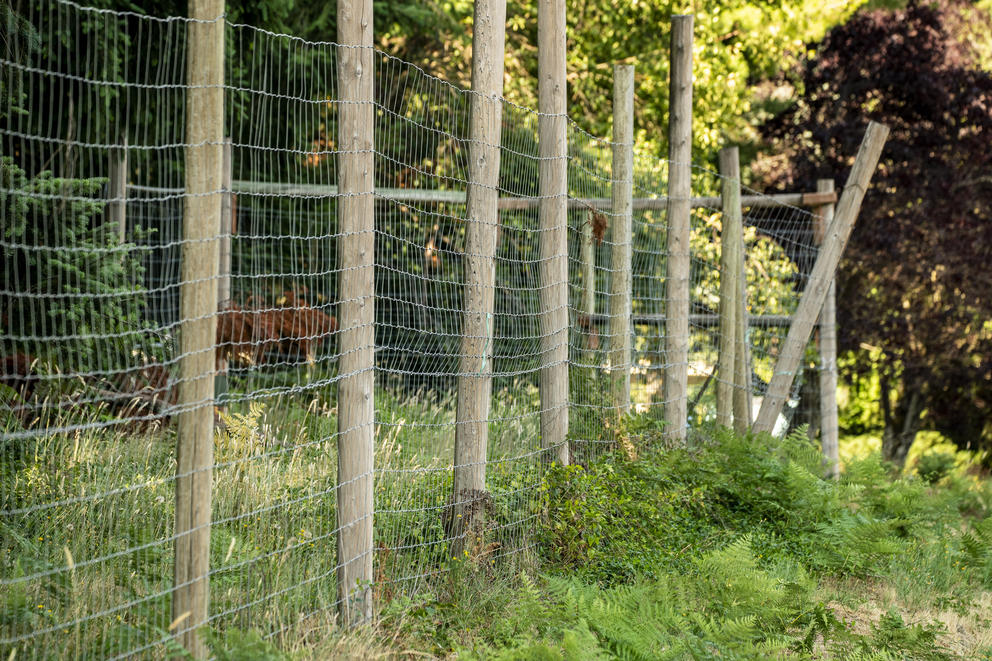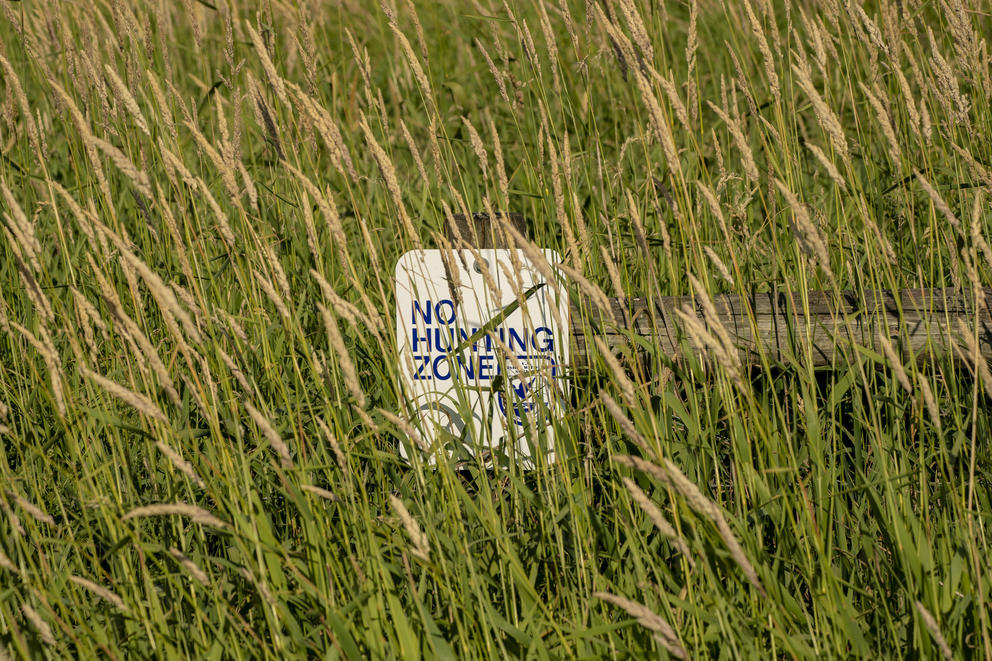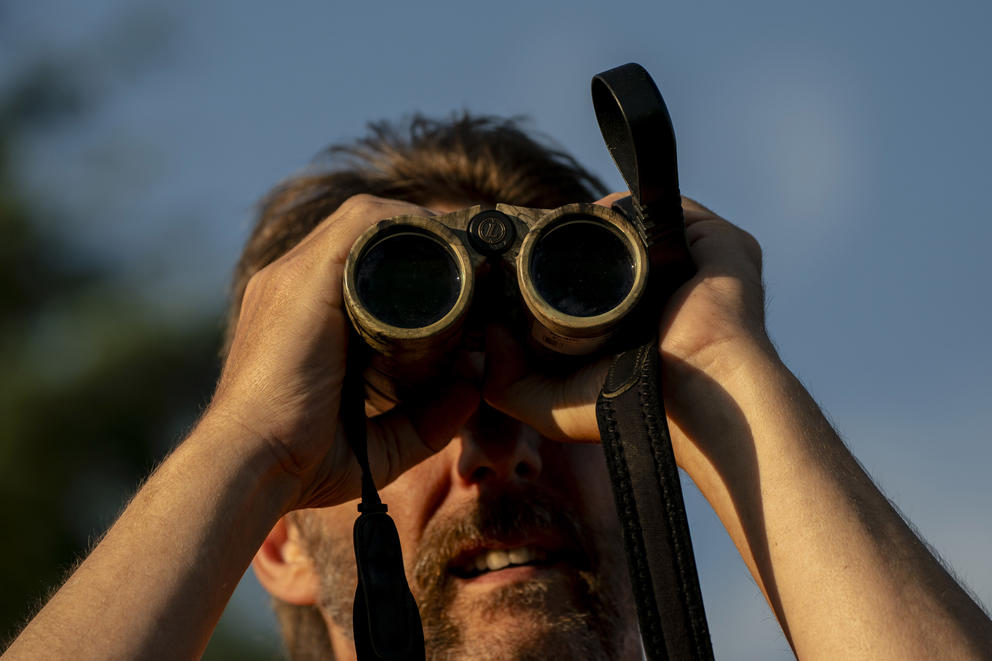Near those trees, he made plans to shoot an elk with a tranquilizer dart, so he could attach a small transmitter to the animal. Novack plotted how he would sneak at night into the line of trees, a heavily used elk gathering spot, then creep up at dawn to sedate them from a safe distance.
This is part of a statewide effort to track how elk roam the area in search of food and safety.
Elk/human interaction can have negative outcomes for both, so state lawmakers are considering consolidating localized elk-management efforts into one statewide plan created by the Department of Fish and Wildlife, Native nations and farmers and landowners – who all deal with the grazing herds. But critics say that the proposal possibly threatens Native treaty rights.
Wildlife biologist Anthony Novack displays a map of salvage permits, which highlights where vehicles have struck elk, at the Washington State Department of Natural Resources offices in Olympia. According to Novack, one of every 300 Washington drivers will eventually hit an elk. (David Ryder for Crosscut)
Two subspecies of elk live all over Washington, with some overlap of territory. Roosevelt elk live on the Olympic Peninsula and Cascade Range, while Rocky Mountain elk live in eastern Washington. Adult elk can weigh 400 to 800 pounds and stand 4 to 5 feet high at the shoulder. Traveling in herds, elk require lots of food – mostly grasses and shrubs, but sometimes plants and produce grown by humans.
This grazing can cause problems in numerous ways. One is with traffic. In Washington, at least 3,000 elk and deer collide with cars each year. One in every 300 Washington drivers will eventually hit a critter on the road, Novack said. One year in the Ocean Shores area, roughly 100 such collisions occurred; in another, vehicles killed 23 elk and 54 deer along a stretch of Interstate 90 between Ellensburg and Vantage.
Another conflict is with agriculture. Elk munch on crops, orchards and bales of hay, cutting into farmers’ profits. Every now and then they graze on golf courses, their hooves punching divots in greens that are a pain to fix.
The state is also trying to prevent the spread of “elk hoof disease” (scientifically called treponeme-associated hoof disease, or TAHD), which showed up in southwestern Washington in 2008 and in eastern Washington 10 years later. It’s passed by elk stepping in spots where diseased elk have stepped before. TAHD causes hoof deformities, limping and general poor health. It’s currently untreatable, though the state’s Department of Fish and Wildlife and Washington State University are researching preventive measures and cures.
An estimated 45,000 to 50,000 elk live throughout Washington, divided into 10 “populations,” or groups, of thousands of elk each, said Kyle Garrison, another Department of Fish and Wildlife biologist. “Each population has different dynamics,” Garrison said.
While a few elk herds have increased in number, most Washington elk populations are meeting the state’s objectives. (When populations rise above these objectives, the state increases the number of hunting permits for that area.) Several populations have faced challenges including disease, harsh seasonal weather and decreasing habitat.
“We’re not deluged by elk,” Novack said.
Elk have caught the attention of Washington’s Legislature. In April, Rep. Debra Lekanoff, D-Bow, introduced House Bill 1849 to require the Department of Fish and Wildlife to set up a statewide elk management plan. The aim is to reduce elk/vehicle collisions and crop damage, as well as improving the health of the herds. The state agency would be required to develop the plan with the state’s Native nations and other Washington government agencies.
Currently, the state has 10 localized management plans for the 10 elk populations. The statewide plan would likely use the Colockum elk herd pilot project in Kittitas County as a blueprint.
Lekanoff said these localized plans vary widely in detail. “We have to balance how we’re able to live together in Washington state,” she said. Lekanoff introduced HB 1849 late in the 2023 legislative session to spark discussion, and will attempt to get the bill passed in next year’s session.
At a March 29 hearing before the House Agriculture & Natural Resources Committee, Lekanoff, an Alaska Native (Tlingit and Aleut) who has worked with the Swinomish Indian Tribal Community, said the bill’s intent is to uphold tribal rights under their treaties with the U.S. and to ensure adequate funding. “[The bill] addresses property damage, but also the health of the herds,” she said.
Rep. Tom Dent, R-Moses Lake, a co-sponsor of the bill, said at the hearing: “We’ve heard a lot of concerns from landowners, ranchers and the public around the state on damage caused by the elk.”
At the hearing, Skagit County Commissioner Ron Wesen said: “We’ve been hearing from east county residents about damage committed on their properties by elk.”
“They’re like hoodlums that we don’t need in our neighborhoods,” said William Schmidt, president of the Skagit County Farm Bureau, at the hearing. He said the county averages roughly 50 vehicle/elk collisions a year.
But some Native nations have raised objections to the draft bill. An official for the Stillaguamish Tribe of Indians sent written testimony to the House Agriculture & Natural Resources Committee in April.
Gary Tatro, wildlife policy representative for the Stillaguamish, wrote that they oppose HB 1849 partly because it threatens treaty rights and the roles of Native nations as co-managers of fish and wildlife.
“It sets a dangerous precedent for wildlife management in Washington State. While the Tribe appreciates the language regarding highway safety and translocation, the idea of inviting other stakeholders to make wildlife management recommendations is unacceptable. In addition, there are 10 elk herds in Washington state and they should be managed separately as opposed to creating a single, statewide management plan,” Tatro wrote. “State agencies and special interest groups should not have input on developing or modifying wildlife management plans.”
Tatro declined to comment directly to Crosscut.
The late-March draft of HB 1849 calls for modifications of the state’s current elk-hunting policies and regulations, including adopting special “depredation” hunts to control herds that are getting into farmland and crops. These include managed hunts with Native nations, with youth and persons with disabilities, and with the general hunting public. Currently, roughly 4,000 to 5,000 elk are hunted annually. The draft also calls for reducing the feeding of elk by anyone outside the DFW.
By working more closely with landowners, the bill requires the state to increase measures to keep elk away from agricultural lands and monitor its progress on those efforts. Deterrence measures include noisemakers, people yelling and chasing elk, and wire fences high enough and strong enough so the animals cannot jump over or bull their way through. The draft bill also requires the state to increase its compensation programs for farmers and others whose cropland fences are damaged by elk.
Also, the bill calls for more research into increasing resources for elk to forage on public and private lands and away from agricultural areas; and for the state to identify appropriate but remote locations for feeding, including marking out routes that would lead elk to those uplands while steering clear of crops.
Meanwhile, as elk management discussions continue, Novack said the state could take other measures to decrease elk/vehicle collisions, including setting up more animal crossings over or under major highways; improved management of roadside vegetation, possibly through herbicides; and leasing more easements on private lands to keep open areas for elk to forage in and migrate through.

